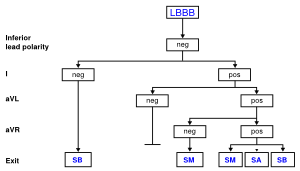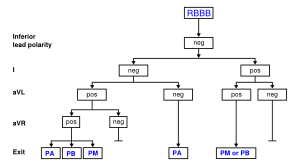Localisation of the origin of a ventricular tachycardia: Difference between revisions
Jump to navigation
Jump to search

m (Created page with '[[File:VT_origins.svg|thumb|Areas of the left ventricle where VT's can originate from: The left ventricle is depicted as having been opened. Regionsare as follows: '''IAS''': inf...') |
mNo edit summary |
||
| Line 1: | Line 1: | ||
[[File:VT_origins.svg|thumb|Areas of the left ventricle where VT's can originate from: The left ventricle is depicted as having been opened. Regionsare as follows: ''' | [[File:VT_origins.svg|thumb|Areas of the left ventricle where VT's can originate from: The left ventricle is depicted as having been opened. Regionsare as follows: '''AB''': anterobasal; '''AM''': mid anterior; '''AA''' anterior apex; '''SB''': basal septum; '''SM''', midseptum; '''SA''', apical septum; '''PB''': basal posterior; '''PM''': mid posterior; '''PA''': posterior apex. Adapted from Miller et al.<cite>Miller</cite>]] | ||
The localisation of the origin (or exit site) of a ventricular tachycardia can be helpful in understanding the cause of the VT and is very helpful when planning an ablation procedure to treat a ventricular tachycardia. | The localisation of the origin (or exit site) of a ventricular tachycardia can be helpful in understanding the cause of the VT and is very helpful when planning an ablation procedure to treat a ventricular tachycardia. | ||
Revision as of 11:42, 9 May 2010

Areas of the left ventricle where VT's can originate from: The left ventricle is depicted as having been opened. Regionsare as follows: AB: anterobasal; AM: mid anterior; AA anterior apex; SB: basal septum; SM, midseptum; SA, apical septum; PB: basal posterior; PM: mid posterior; PA: posterior apex. Adapted from Miller et al.[1]
The localisation of the origin (or exit site) of a ventricular tachycardia can be helpful in understanding the cause of the VT and is very helpful when planning an ablation procedure to treat a ventricular tachycardia.
Using this approach and the algorithm on the right (to be added soon) [2] the exit site can be estimated with reasonable accuracy (PPV around 70%).



